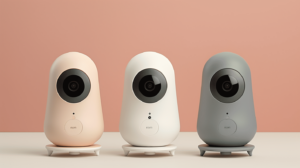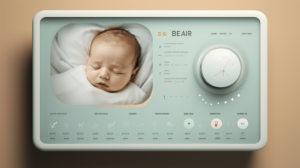
Nanit Baby Monitor: Features and Recommendations
Discover the impressive features of the Nanit Baby Monitor and get valuable recommendations on choosing the perfect one for your baby’s safety and comfort.

As a new parent, the safety and well-being of your baby are on top of your priority list. To help you ensure that your little one is safe and sound, even when you’re not in the room, baby monitors have become an essential part of modern parenting. In the market, there are two primary types of baby monitors: Wi-Fi and Non-Wi-Fi baby monitors. In this article, we will explore the advantages and disadvantages of both types and offer some recommendations for you to make an informed decision.
Wi-Fi baby monitors, also known as smart baby monitors, connect to your home’s wireless network and allow you to monitor your baby through a smartphone or tablet app. These devices often come equipped with a variety of features to provide a comprehensive monitoring solution:
High-quality cameras offer real-time video feeds, allowing you to keep a close eye on your little one. Some Wi-Fi baby monitors even provide night vision, so you can check on your baby in low light conditions.
This feature allows you to communicate with your baby remotely, soothing them with your voice without having to enter the room.
Many Wi-Fi baby monitors come with built-in sensors that track your baby’s temperature, humidity, and air quality in the room. The device sends alerts to your smartphone if any changes are detected, ensuring a comfortable environment for your child.
Non-Wi-Fi baby monitors, also known as traditional baby monitors, do not require an internet connection. Instead, these devices use radio frequency (RF) or Digital Enhanced Cordless Telecommunications (DECT) technology to transmit audio and/or video signals from the baby’s room to a dedicated parent unit.
These monitors allow you to hear your baby’s sounds through a dedicated parent unit. Some audio-only monitors include a visual sound indicator, vibration alerts, or adjustable sound sensitivity.
These monitors come with cameras that transmit video feeds, in addition to sound, from the baby’s room to the parent unit. Many audio-video monitors include features such as infrared night vision, zoom capabilities, and pan or tilt options.
| Pros | Cons |
| Remote access from anywhere with an internet connection | Dependence on a stable Wi-Fi connection |
| Wide range of features, including video streaming, two-way talk, and sensors | Potential privacy concerns, as data is transmitted over the internet |
| No need for a separate parent unit | Higher price compared to traditional baby monitors |
| Easy to integrate with other smart home devices | May consume more data and bandwidth compared to non-Wi-Fi alternatives |
| Pros | Cons |
| Less dependence on a reliable internet connection | Limited range compared to Wi-Fi monitors |
| Generally more affordable than Wi-Fi baby monitors | Requires a dedicated parent unit |
| Potentially lower risk of security breaches | Less advanced features, generally limited to audio and/or video transmission |
| Lower data and bandwidth usage | Signal interference may affect audio/video quality |
When choosing between Wi-Fi and non-Wi-Fi baby monitors, it’s essential to consider your specific needs, preferences, and budget. If you value remote access, advanced monitoring features, and integration with other smart home devices, a Wi-Fi baby monitor may be right for you. However, keep in mind that these monitors usually come at a higher price and are dependent on a stable internet connection.
If you’re looking for a more affordable option and don’t require advanced features, a non-Wi-Fi baby monitor may be the better choice. These monitors are generally easier to set up, and as they do not rely on an internet connection, there are fewer privacy and security concerns.
No matter which type of baby monitor you choose, it is crucial to opt for a well-reviewed, reputable brand. Additionally, always remember that baby monitors are not a substitute for direct supervision, but merely another tool in ensuring your baby’s safety.
While there is a risk of any internet-connected device being hacked, a reputable Wi-Fi baby monitor with robust security features and regular software updates offers a higher level of protection. Always use strong, unique passwords and ensure that your home Wi-Fi network is secure as well.
Not all Wi-Fi baby monitors require a subscription. While some offer additional features or storage options with a subscription plan, many come with sufficient monitoring functionalities without the need for extra fees.
The range for non-Wi-Fi baby monitors varies depending on the model and technology used. Generally, audio-only monitors have a range of approximately 600-1000 feet, while audio-video monitors may have slightly shorter ranges. However, the actual range may be affected by factors such as physical obstructions and signal interference.
Yes, you can use multiple baby monitors in the same household. Most non-Wi-Fi baby monitors offer multiple channels, allowing you to switch channels to minimize interference. In the case of Wi-Fi baby monitors, interference is less of an issue. You can connect multiple cameras to the same smartphone or tablet app for convenient monitoring of different rooms.
Baby monitors use radio frequency (RF) or Digital Enhanced Cordless Telecommunications (DECT) technology to transmit signals, which emit low levels of radiation. Research has shown that the radiation levels emitted by baby monitors are far below the levels considered harmful. However, it is recommended to keep the monitor at a safe distance from the baby’s crib, following the specific guidelines provided by the manufacturer, to minimize any potential risks.
Be the first to See our Posts and latest Guides, and Special Offers like Lovelycheeks on Facebook or follow us on Pinterest!

Discover the impressive features of the Nanit Baby Monitor and get valuable recommendations on choosing the perfect one for your baby’s safety and comfort.

Discover the pros and cons of using baby monitor apps, along with expert recommendations for the best ones available. Keep your baby safe and monitored.

Discover the features and benefits of Owlet baby monitors with our comprehensive guide. Ensure the safety and peace of mind of your baby with Owlet.

Discover essential baby monitor hacks that will make life easier for busy parents. Learn tips and tricks to ensure the safety and well-being of your baby.